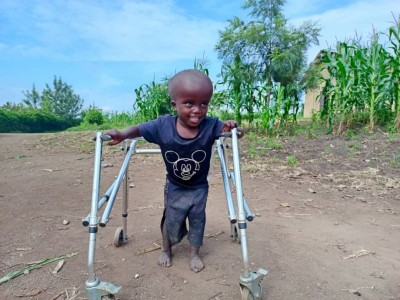The sheer size of the settlement is awe-inspiring, as are the challenges posed by its expanse. Movement to any destination is not easy, especially without transport and even with transport the roads can be challenging for vehicles especially in the rainy season.
Everywhere, people move with purpose; children walking to school, adults heading to work, motorcycles laden with people and goods, and the occasional car are all vying for space on the road.
The Ugandan Government has taken a progressive approach to receiving refugees and the Kyaka I refugee settlement was created in 1984 following the decision to host refugees in designated areas. Kyaka II was established and replaced Kyaka I in 2005.
The UN refugee agency (UNHCR, 2022 & 2024) reports that Kyegegwa District has 134,199 refugees, 19% of the total population in the area. 77% of the refugees are women and children. 95% of refugees are Congolese, escaping conflict, persecution and instability in the Democratic Republic of Congo (UNHRC, 2022).
In the last two years there has been a large influx of refugees across Uganda, including Kyaka II, as people flee civil war in neighbouring countries, as well as extreme weather. The Ugandan Government has consistently provided refugees with land on settlements, allowing refugees to build homes, work the land, and create lives of stability, however limited their choices might be. Homes range from mud structures to concrete builds, each with its own story of resilience and adaptation.
Children on the Edge has set up and currently supports over 200 cluster learning groups for 5,000 young children across zones 1-5 of the settlement and caregivers are currently being recruited and trained for further groups in other settlement zones.
Cluster groups aim to provide safe spaces where children can engage in playful learning approaches alongside familiar adults who care for and listen to them. Early education is positioned right at the heart of each community.
The caregivers are local community members selected and trained by COTE, in collaboration with communities, to lead and manage play-based learning. This gives agency and empowers whole communities and creates value for specific individuals (caregivers) within each community.
I was fortunate enough to visit six outdoor cluster learning sessions during my trip. Cluster groups offer early education to children aged 3–6 years for three hours a day, three days a week and each cluster group has children divided by age into three groups; baby group, middle group and top group.
COTE insists on a ratio of 1 adult to 15 children which promotes child safety, learning outcomes, and overall well-being. COTE never turns children away, their ‘learning for all’ philosophy is clear; when the ratio rises, another caregiver is found.
This practice is not common and whilst on my visit, I met community teachers from other organisations working in ratios of 1:50 and above which is hard to imagine.
As we drove up to the first cluster group, I peered down a narrow pathway amidst the maize and banana plants and saw and heard lively children and caregivers in a circle singing along enthusiastically to action rhymes in a small clearing.






